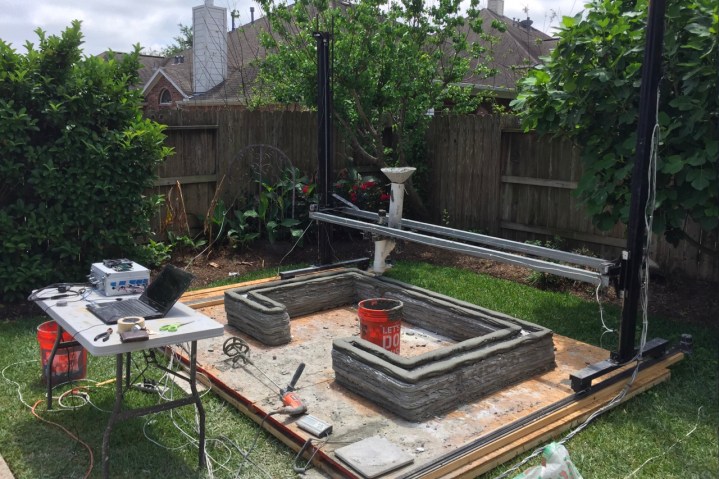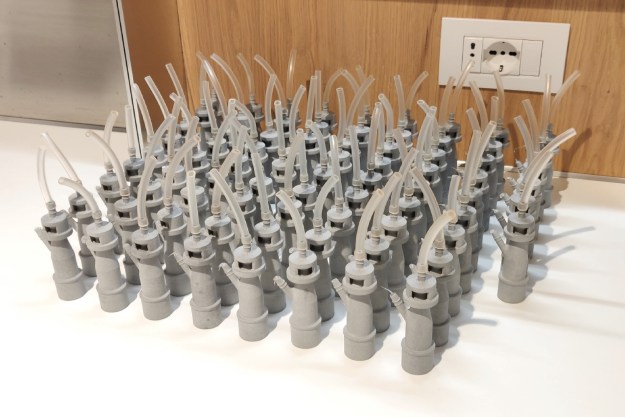
The technology behind 3D printing is probably older than you’d think, but only because recent advancements in the field have made it a viable commercial venture. These days, you can 3D print just about anything. From small tools (like hinges and screws), to games, home decor, art, and even prosthetic limbs and cars, if you can dream it, you can print it.
Some companies are even 3D printing entire houses, which could have major implications for society as well as help alleviate housing crises around the world. Besides being more customizable and sustainable than traditional housing, 3D-printed houses are cheaper and can be built more quickly (sometimes in just a few hours), providing much needed housing alternatives in lower-income areas or areas impacted by natural disasters.
3D-printed buildings also just look really cool. Layering hundreds and thousands of rows or concrete or bio-plastics together to create strong supporting walls that provide shelter and insulation, 3D-printed houses are not only challenging what we think of when we think of buildings — but how we create them. Here are just a few of our favorite 3D-printed homes.
Photo: ModEco Development LLC
Urban Cabin (Amsterdam, Netherlands)

Made using renewable bio-plastics, the Urban Cabin, by DUS Architects, offers sustainable micro-dwellings in urban environments. The structure is entirely 3D-printed and showcases different techniques for insulation and material consumption. The pieces are printed off-site, shipped to a specified location and the cabin is assembled. The Urban Cabin only takes up 25 cubic meters, including the space needed for the structure itself, as well as an outdoor tub and “pocket park” grass lawn. Inside, it has enough space for a window, door, and bed, which can be folded into a seat when not in use. If need for the cabin should ever dissipate, the materials used can be shredded and recycled for other 3D printing projects.
Photo: DUS Architects
Apis Cor’s 3D-Printed House (Stupino, Russia)

The Apis Cor house is believed to be the first 3D-printed house created entirely on-site, rather than assembled from pre-printed parts. It was constructed at the Apis Cor test facility in Stupino, Russia in the winter of 2016. After the walls were completed (in just under 24 hours), the printer was removed through the top of the building with a crane, and the roof, windows, interior, and a few coats of mustard yellow paint were finished by hand. The interior of the house includes a hall, bathroom, living room, and kitchen. The technology used to construct this house could be used to build houses of any shape and in temperatures as low as 5 degrees Celsius. The total cost of the Apis Cor house was just over $10,000.
Photo: Apis Cor
3D-printed Castle (Shorewood, Minnesota)

While not exactly a house, this 12-foot-tall castle was created using one of the first concrete 3D printers. Andrey Rudenko of Total Kustom, a robotics company out of Shorewood, Minnesota, created the structure in his own backyard. It took him two years to construct, including designing his own printer, and one small garage fire, according to the Star Tribune. Rudenko first started producing concrete boxes, but eventually was able to start work on the castle. Heavy rain delayed the construction, but once the 7-foot base was finished, he was able to add the battlements and spires, which had been printed separately. Total Kustom also created a custom 3D-printed hotel suite for a client in the Philippines (more on that later).
Photo: Total Kustom
Landscape House (TBD)

Construction and architectural firms BAM and Universe Architecture have joined forces to create a giant Möbius strip building, which they are calling the Landscape House. The two-story structure will be about 100 meters long and include 1,000 square meters of floor space. The idea behind the twisted building was first unveiled in 2013, and while they have been making progress (including testing the form in a park bench at the end of 2015), they have yet to start printing the real thing just yet. The entire project is estimated to cost $5.3 million and the 3D-printer will need to be active for at least 6 months to make this unique building a reality.
Photo: Universe Architecture
Icon’s 3D-Printed House (Austin, Texas)

This 3D-printed house has the potential to impact a very real problem: Homelessness. Icon, an Austin-based startup, is teaming up with non-profit New Story to create 3D-printed homes in underserved communities. There is currently only one model of this house on-display in Austin, Texas, but the companies plan to begin construction on more homes in the coming year. What sets this house apart from others like it, is that it is believed to be the first 3D-printed structure that is fully permitted and up to code. It has a living room, bedroom, bathroom, and porch. The 600 square foot abode can be printed in 12-24 hours and costs $10,000. Icon hopes to bring that number down to $4,000 per house.
Photo: Icon
Curve Appeal (TBD)

What started as a concept for a freeform home design challenge could soon become an actual product with WATG‘s freeform 3D-printed house. The design, created by multiple members of the Chicago-based architecture firm, is made up of two main components: A exterior skin and interior core, which includes a kitchen, bathroom, living area, and bedroom. Unlike other 3D-printed structures, the Curve Appeal relies more heavily on glass and natural lighting in conjunction with it’s 3D-printed parts, allowing it to more easily mirror modern architecture and blend with the natural environment. According to their website, WATG was expected to begin 3D printing the building in 2017, but the final product remains to be seen.
Photo: WATG
3D-Printed Hotel Suite (Angeles City, Philippines)

The Lewis Grand Hotel is a luxury hotel in Angeles City, Philippines. What sets the Lewis Grand apart from its competitors is its 3D-printed hotel suite. Measuring 10.5 meters by 12.5 meters, with two bedrooms, a living room, and Jacuzzi, the suite is the first-ever operational commercial structure made through 3D printing. The whole structure took about 100 hours to produce and was made by Total Kustom, the Minnesota company responsible for the 3D-printed castle earlier in this list.
Photo: Total Kustom
Tiny Home (Houston, Texas)

As a student at Baylor University, engineer Alex Le Roux designed and built a concrete 3D printer. The 3D concrete printer — which Le Roux calls the Vesta — was able to print the small structure in just 24 hours, with a print speed of .3 feet per second. The tiny home has a single door and an interior of 7 x 4 feet. The house was built in Houston, Texas, and was funded in part by Le Roux himself and the architectural firm ModEco Development LLC. It was constructed using inexpensive Portland cement mix, a common building material. Not only does this house prove how many people are hard at work creating sustainable buildings, but also the many different kinds of unique printers used to make unique buildings.
Photo: ModEco Development LLC
Editors' Recommendations
- 3DMakerpro’s Seal is a pocket-sized scanner to make next-gen precision 3D prints
- Need a last-minute Halloween costume? Check out these 3D-printable getups
- The future of making stuff: Inside the evolution of 3D printing with Formlabs
- Father’s Day Gift Idea: These cheap 3D printers are on sale for less than $300
- 3D printing lets hospitals make ventilator substitutes with common equipment


